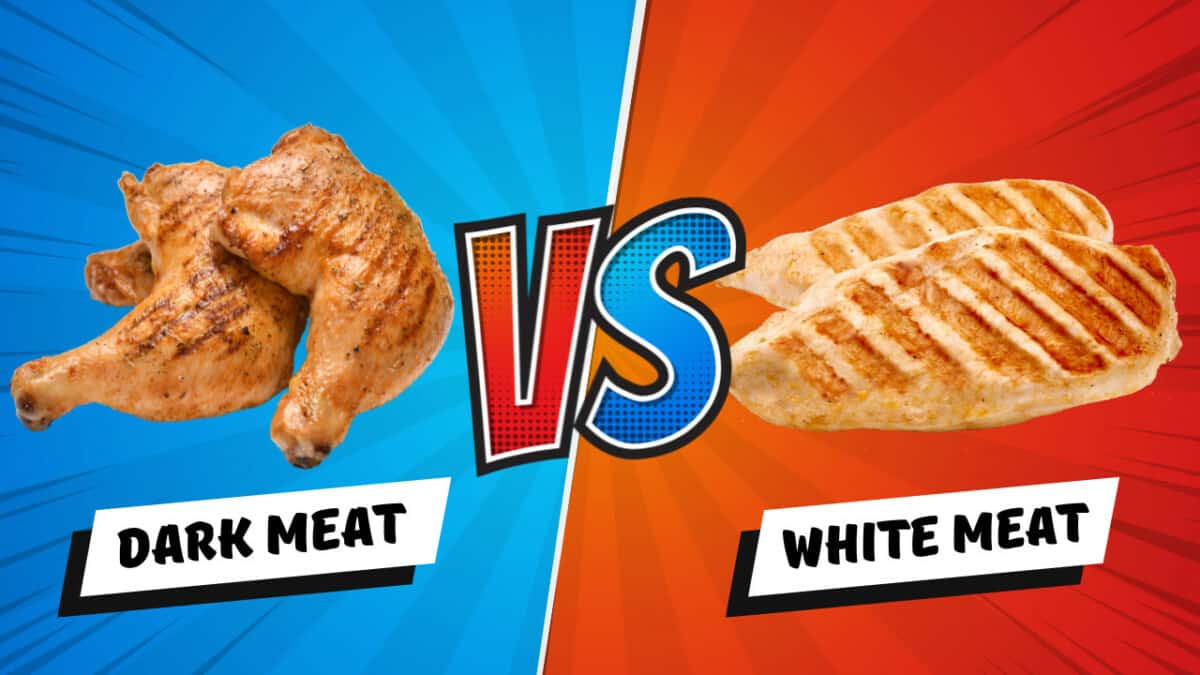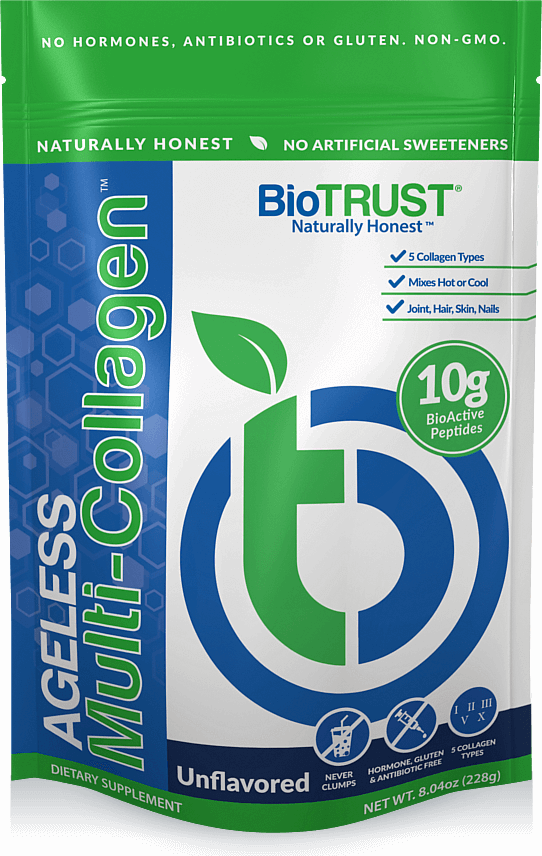If you’re wondering which is nutritionally better for you, dark meat or white meat, this article will provide a simple and straightforward answer. This article will break down the nutritional benefits, pros and cons of both.
Knowing the nutritional nuances between dark and white meat will empower you to make the best nutritional food choices in your diet. Debunking common myths about white and dark meat will unlock the truth so you can choose the healthier option for you.
There is a lot of confusing and conflicting advice out there about white and dark meat. But here, we’ll clear the air once and for all in the debate about dark meat vs. white meat.
Is Dark Meat Healthier Than White Meat
Quick Answer:
Dark meat contains more micronutrients than white meat. Dark meat has zinc, selenium, riboflavin, iron, niacin, thiamine, vitamins B6 & B12, and amino acids like taurine. White meat contains less fat and a little more protein. Both are protein rich food sources, white meat has less calories.
White meat can be a better option for weight loss since it contains less calories. But dark meat is nutritionally dense and a great choice as long as you factor in their slightly higher calories into your diet plan.
White meat has been commonly known as the “healthier” choice over dark meat. It has less fat and cholesterol than dark meat, so this makes it the clear and healthier option… right?
While white meat has nutritional benefits, especially its protein content, dark meat has more nutrients. And if you break down the actual fat and calorie content, there isn’t much difference between the two.
So why has white meat been praised as the healthier choice over dark meat? It all goes back to the 1960s when the sugar lobbyist was able to push their agenda that fats were the cause of being overweight and heart disease.1
In 1967, the Sugar Association funded “research” for a study that downplayed sugar’s role in obesity and heart disease. And instead put the blame on dietary fats.2
Then, in the 1970s, the U.S. government’s dietary guidelines emphasized reducing fat intake. If you grew up in the 1980s like me, you’ll know they promoted eating a higher carbohydrate and sugar diet.
Since the 1980s, obesity and heart disease have skyrocketed! Obesity rates have tripled.3 And only recently have studies found that the last 40 years of eating the recommended low-fat/high-carbohydrate diet is NOT a good idea.4
So dietary fat isn’t bad for you and shouldn’t be viewed as the devil. Your body needs healthy fats for optimal health and hormonal balance.5 If anything, sugar and carbohydrates (especially refined) should be drastically limited in your diet.
Why Dark Meat is Nutritionally Better
So, what are the differences between white meat and dark meat?
The color of the meat is determined by the amount of myoglobin in it. Myoglobin is a molecule in red blood cells that helps carry oxygen. So, the muscles that are used all the time need to carry lots of oxygen, and therefore, they will have lots of myoglobin.
Chickens and turkeys spend most of their time standing and walking around. This is why turkey and chicken thighs are dark meat while the breasts and wings are white.
The nutrition facts by the Department of Agriculture6 states:
- 3 oz. of turkey breast contains: 160 cal, 6g of fat, 24g of protein
- 3 oz. of turkey thighs contains: 190 cal, 10g of fat, 23g of protein
- 3 oz. of chicken breast contains: 170 cal, 7g of fat, 25g of protein
- 3 oz. of chicken thighs contains: 210 cal, 13g of fat, 21g of protein
You can see the white meat in both chicken and turkey has a little more protein than the dark meat. But the difference is a really small amount to make one way better than the other.
Thigh meat contains more fat than breast meat, but dietary fat shouldn’t be demonized. It won’t be a big deal if you’re factoring in the calorie difference in your diet. Fats from the thigh meat can also help blunt your blood sugar response if eating it with carbs.7
If you’re trying to reduce your calorie intake, I’d go with the white meat. But you’ll be doing so at the expense of micronutrients. Considering most people are micronutrient deficient, you’ll miss out by always going with white meat over dark meat.
You’ll be missing out on these micronutrients by avoiding dark meat:
- Zinc: boosts your immune system, speeds up wound healing, supports growth development
- Selenium: Powerful antioxidant, elevates thyroid health, boosts immune system, heart healthy
- Riboflavin: Essential for energy production, visionary health, healthy skin and hair, nervous system functioning
- Iron: Energy metabolism, immune system strength, oxygen transport, cognitive health
- Niacin: boosts metabolism, heart healthy, mental clarity, mood booster, skin health, anti-aging
- Thiamin: energy production, heart health, nervous system, mental clarity, mood booster
- Vitamin B6: boosts metabolism, improves mental health, boosts immune system, heart health
- Vitamin B12: energy booster, strengthens metabolism, heart health, anti-aging health
- Taurine: inflammation fighter, blood pressure regulator, healthy nerve function, anti-aging
Even though white meat has a little more protein and fewer calories, that doesn’t mean it’s better in all ways. I usually prefer dark meat since it contains more micronutrients for overall health. If you’re eating more white meat, make sure you’re getting your micronutrients from other foods so you don’t become deficient.
It’ll also depend on your personal choice. If you just prefer the taste of white meat, then there’s nothing wrong with eating that most of the time. If you prefer dark meat, then you should eat that most of the time.
The fats in dark meat make it more flavorful. White meat is dryer than dark meat, so people sometimes top it with a sauce that contains sugar and seed oil for flavor. If you’re eating white meat because it contains fewer calories but then dump tomato sugar sauce (ketchup) on it, you’ll be defeating the purpose.
Key Takeaways:
- White meat has a little more protein, less calories, and less fat
- Dark meat contains micronutrients that have additional health benefits
- Go with the meat that you personally prefer. If you have to put a sauce on it, then it’ll take away health benefits
What Meats Are Dark Meat
Dark meat, which we usually call poultry meat, isn’t the same as red meat, which is beef, lamb, and pork. While red meat has been linked to increased cancer risk (which is another debate), dark poultry meat has way less saturated fat. It is usually viewed as the healthier choice.
Salmon and tuna might look like “red meat,” but they are actually considered a fatty fish. Salmon is pinkish red because of eating tiny shrimp or krill that have this pigment coloring.
Dark meat itself is not carcinogenic (cause cancer), but any meat could be depending on how it’s cooked and processed. Cooking at high temperatures, like grilling and frying, could produce carcinogenic chemicals. Advanced glycation end products (AGEs) can also form when cooking at high temperatures and accelerate aging.8
Here are some examples of dark meats:
- Chicken:
- Legs (drumstick and thigh)
- Thighs
- Turkey
- Thighs
- Duck
- most duck meat is dark since duck is very active
- Goose
What Meats Are White Meat
White meat refers to poultry and light flaky fish like cod, haddock, tilapia, and halibut.
Some might call certain pork cuts, such as tenderloin and pork loin, “the other white meat,” but they’re still nutritionally red meat.
Here are some examples of white meats:
- Chicken breasts
- Chicken wings
- Turkey breast
- Turkey wings
- Light and flaky fish
- cod
- halibut
- haddock
- tilapia
Ground turkey or ground chicken meat can be confusing if they’re white meat or dark meat. The packaging label will usually say if it’s dark meat or white meat. But if it doesn’t, then the ground turkey or chicken could be a mix of both.
Don’t Throw Out the Skin

The skin is usually considered the unhealthiest part of chickens. This is because chicken skins contain a high amount of saturated fats and calories. But if you pull off and toss away that skin, you’ll miss out on some highly beneficial nutrients.
One of the reasons I recommend rotisserie chickens is because they come with the skin. Chicken and turkey skin is rich in collagen.8 Collagen is the most abundant protein in your body but declines with age. This causes wrinkles, sagging skin, crepey skin, and other age-related skin conditions.9
So the more collagen you can get in your diet, the better. By only eating boneless, skinless chicken or turkey you’ll be depriving yourself of valuable collagen. Getting more collagen in your diet has been found to reduce the appearance of wrinkles, improve skin elasticity, thicken hair, and strengthen joints.10
Contains 5 of the key types of collagen in scientifically ideal forms. Uses hydrolyzed collagne peptides making it easier to digest. Mixes easily, no clumping, with no odor or taste.
- Supports healthy, youthful looking skin & skin elasticity
- Supports joint health & comfort
- Supports hair health & growth
- Supports healthy body composition
Chicken and turkey skin also contain monounsaturated fats, the same kind of healthy fat found in avocados and olive oil. 1 oz. of chicken skin contains 3g of saturated fat and 8g of unsaturated fat.
And don’t throw out the bones from the rotisserie chicken! You can use the bones and drippings to make delicious and nutrient rich bone broth. Just use a slow cooker or even a big pot of water to make the bone broth. Bone broth is collagen dense and also glucosamine that benefits your joints.
Summary
White and dark meat aren’t a whole lot different until you start breaking down the nutritional nuances. Dark meat has more micronutrients, more dietary fat, and is more flavorful. White meat has a little more protein, less dietary fat, is dryer, and has less flavor.
At the end of the day, white and dark meat both have their benefits. If you’re really trying to minimize your calories for weight loss, then white meat is the better choice. But dark meat has the advantage if you want to maximize your health.
That said, if you don’t like the dryness and less flavorful white meat chicken or turkey, you shouldn’t force yourself to eat it all the time. Instead, just have a slightly smaller portion of dark meat to make up for the calorie difference.
Dark meat is also usually cheaper than white meat. So, if you’re on a budget and want to stretch your dollar, dark meat is the clear winner. Both have their advantages, but 9/10, I’ll go with dark meat over white meat.
Josh holds a Bachelor’s degree in Exercise Physiology and Nutrition Science. He’s a Certified Strength and Conditioning Specialist (CSCS) by the National Strength and Conditioning Association and he’s a Certified Personal Trainer (CPT) by American Council on Exercise. He’s worked as a Strength and Conditioning Coach at the high school and college levels. He has over 15 years of experience as a personal trainer and nutrition coach. He strives to bring inspiration and results for people to live healthier lives through smart diet and exercise.







